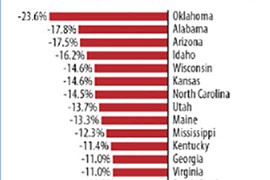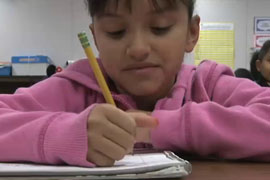- Slug: BC-CNS-School Funding,570
- Sidebar: How Arizona ranked
- Photos available (thumbnails, captions below)
By MIRANDA RIVERS
Cronkite News
WASHINGTON – Arizona’s per-pupil spending has fallen 17.5 percent since 2008, the third-deepest rate of K-12 education cuts in the nation, according to a report released Thursday.
The Center on Budget and Policy Priorities report said most states saw a drop in per-student spending from the start of the recession to the current fiscal year, but Arizona was one of the few above 15 percent.
Arizona trailed only Oklahoma, at 23.5 percent, and Alabama’s 17.8 percent drop.
Advocates said the impact of the cuts can be seen across the state in larger class sizes, teacher shortages and what one called the “unthinkable” elimination in 2010 of full-day kindergarten.
“When you start talking about six years of cuts you can do everything possible to protect the classroom, but then there is nowhere else to cut,” said Janice Palmer, director of governmental relations and public affairs at the Arizona School Boards Association.
Help could be on the way, after state courts ruled that the Legislature had not adjusted school aid for inflation under a funding formula that is part of Proposition 301, approved by voters in 2000.
As a result of those rulings, a Maricopa County Superior Court judge this summer ordered the state to restore $317 million to schools in this fiscal year and a total of $1.6 billion over five years.
Palmer said any increased funding for schools would just be “making us whole.”
Andrew Morrill, president of the Arizona Education Association, said underfunding schools was happening in the state long before the recession.
“We have over 500 teaching positions across the state that are not filled,” Morrill said. “We are seeing more and more teachers at the start of the year saying, ‘I can’t afford to teach anymore.'”
Chris Kotterman, director of governmental relations at the Arizona Department of Education, said the effects of education cuts are felt in districts across the state.
“This is a statewide problem that affects every school,” Kotterman said. “Everybody shares this equally.”
Kotterman said the gradual decrease in education funding over the years means school systems “haven’t been able to give out things that normal companies can give out to keep employees.”
“Districts are having to scrape together and find money where they can because the state’s not paying for it,” he said.
Palmer said the court ruling was a win for schools, but to make it a complete success lawmakers must appropriate those funds immediately.
“We are fighting like mad for those increases to happen as soon as possible,” Palmer said. “Our top priority is getting the inflationary funding actually appropriated to our schools.”
Morrill agreed that schools in the state cannot afford to wait.
“The legislature and those running for office on the public trust should attempt no further delays and should move to fund that court order as fast as they can,” he said.
Later this month, the Superior Court will hear arguments on whether the state should be required to provide an additional $1.3 billion in back pay to schools.
Palmer said the struggles that Arizona’s schools are facing reflect a state mindset that needs to change.
“Education needs to be the top priority of the state. I think other states have prioritized education higher than we have,” Palmer said.
Morrill agreed.
“Something’s got to change,” he said. “We are taking money out of teacher’s salaries and taking money out of classrooms for students.”
^__=
Web Links:
_ CBPP Report: http://www.cbpp.org/files/10-16-14sfp.pdf
_ Arizona School Boards Association: http://www.azsba.org/
_ Arizona Department of Education: http://www.azed.gov/
_ Arizona Education Association: http://www.arizonaea.org/
_ Prop 301: http://www.azsos.gov/election/2000/Info/pubpamphlet/english/prop301.pdf
^__=
SIDEBAR:
How Arizona ranked
A Center on Budget and Policy Priorities report on school spending said most states saw a decrease after the recession, but Arizona had one of the biggest drops in its rate of per-pupil spending since then. States with the steepest cuts were:
1. Oklahoma: -23.6 percent
2. Alabama: -17.8 percent
3. Arizona: -17.5 percent
4. Idaho: -16.2 percent
5. Wisconsin: -14.6 percent
6. Kansas: -14.6 percent
7. North Carolina: -14.5 percent
8. Utah: -13.7 percent
9. Maine: -13.3 percent
10. Mississippi: -12.3 percent
^__=
Arizona faced school spending cuts during the recession, like many states, but it has yet to bounce back from those reductions, according to a recent national report, which said the state posted the third-steepest drop in the nation. (Chart courtesy the Center on Budget and Policy Priorities)
Advocates say the state cuts to funding for education can be seen in larger classes, fewer teachers and the loss of all-day kindergarten, among other cuts. (Cronkite News photo by Vaughn Hillyard/Jessica Goldberg)

